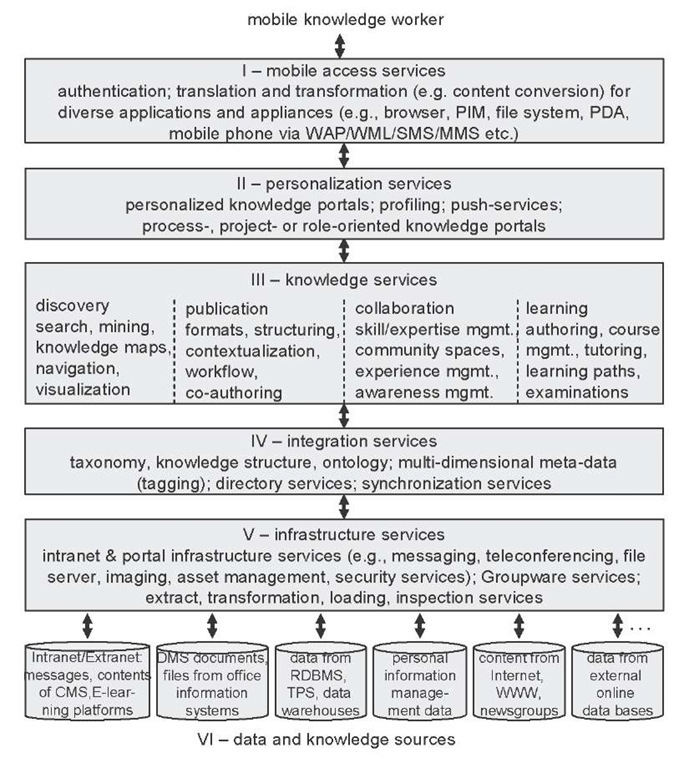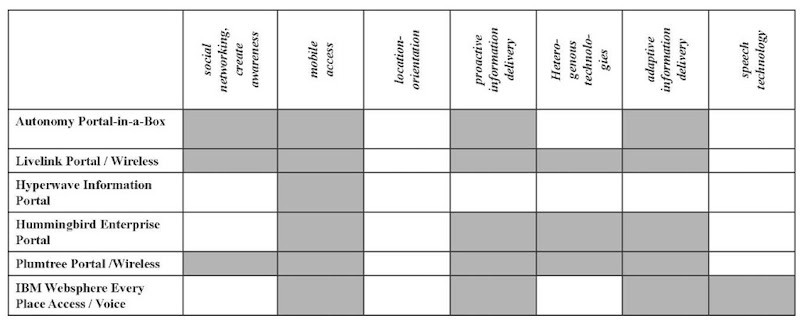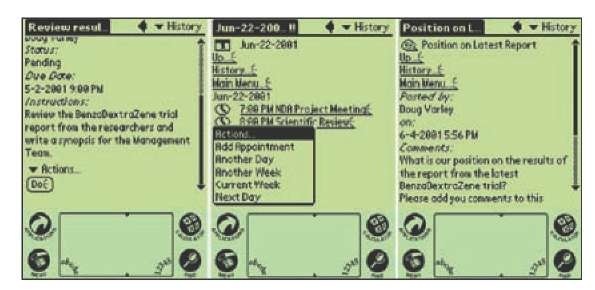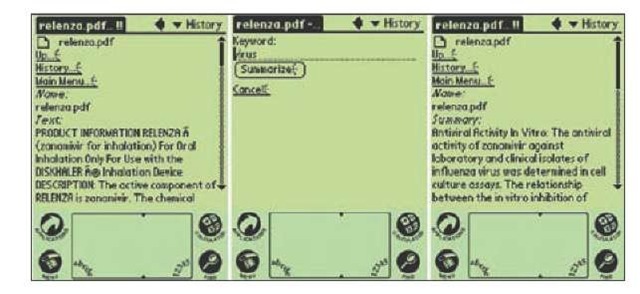INTRODUCTION
More and more people leave their fixed working environment in order to perform their knowledge-intensive tasks at changing locations or while they are on the move. Mobile knowledge workers are often separated from their colleagues, and they have no access to up-to-date knowledge they would have in their offices. Instead, they rely on faxes and messenger services to receive materials from their home bases (Schulte, 1999). In case of time-critical data, this way of communication with their home office is insufficient.
Mobile knowledge management (KM) has been introduced to overcome some of the problems knowledge workers are faced when handling knowledge in a mobile work environment (e.g., Berger, 2004; Grimm, Tazari, & Balfanz, 2002,). The main goal of mKM is to provide mobile access to knowledge management systems (KMS) and other information resources, to generate awareness between mobile and stationary workers by linking them to each other, and to realize mobile KM services that support knowledge workers in dealing with their tasks (see chapter, “A Mobile Portal for Academe: The Example of a German University” ).
So far, most of the off-the-shelf KMS are intended for the use on stationary desktop PCs or laptops with stable network access, and provide just simple access from mobile devices. As KMS are generally handling a huge amount of information (e.g., documents in various formats, multimedia content, etc.) the limitations of (mobile) information and communication technologies (ICTs), like mobile devices such as PDAs and mobile phones, becomes even more crucial (Hansmann, Merk, Niklous, & Stober, 2001). Mobile devices are usually not equipped with the amount of memory and computational power found in desktop computers; they often provide small displays and limited input capabilities, in comparison to wired networks, wireless networks generally have a lower bandwidth restricting the transfer of large data volumes and due to fading, lost radio coverage, or deficient capacity, wireless networks are often inaccessible for periods of time.
Today, many KMS are implemented as knowledge portals, providing a single point of access to many different information and knowledge sources on the desktop together with a bundle of KM services. In order to realize mobile access to knowledge portals, portal components have to be implemented as mobile portlets. That means that they have to be adapted according to technical restrictions of mobile devices and the user’s context.
This contribution identifies requirements for mobile knowledge portals. In particular, it reviews the main characteristics of mobile knowledge portals, which are considered to be the main ICT to support mobile KM. In addition, it outlines an important future issue in mobile knowledge portals: The consideration of location-based information in mobile knowledge portals.
MOBILE KNOWLEDGE PORTALS
Most knowledge management systems (KMS) are implemented as centralized client/server solutions (Maier, 2004) using the portal metaphor. Such knowledge portals provide a single point of access to many different information and knowledge sources on the desktop, together with a bundle of KM services (cf. Collins, 2003; Detlor, 2004), for example, contextualization, semantic search, collaboration, visualization and so forth. The added value of these portals compared to other KM tools is the integration of technologies for storage of, and access to, information and knowledge, with the ones for support of the interaction and collaboration activities in a unique entity (Loutchko & Birnkraut, 2005). Typically, the architecture of knowledge portals can be described with the help of KMS-layers (Figure 1, Maier, 2004).
The first layer includes data and knowledge sources of organizational-internal and external sources. Examples are database systems, data warehouses, enterprise resource planning systems, content and document management systems. The next layer provides intranet and portal infrastructure services as well as groupware services, together with services to extract, transform, and load content from different sources. On the next layer, integration services are necessary to organize and structure knowledge elements according to a taxonomy or ontology.
Figure 1. Layer architecture of knowledge portals
The core of the architecture consists of a set of knowledge services in order to support discovery, publication, collaboration, and learning. Personalization services are important to provide a more effective access to the large amounts of content, that is, to filter knowledge according to the knowledge needs in a specific situation, and offer this content by a single point of entry (portal). In particular, personalization services, together with mobile access services, become crucial for the use of KMS in mobile environments.
Portals can be either developed individually or by using off-the-shelf portal packages, such as BEA WebLogic, IBM Portal Server, Plumtree Corporate Portal, Hyperwave Information Portal, or SAP Enterprise Portal. Most of these commercial packages can be flexibly customized in order to build up more domain-specific portals by integrating specific portal components (so called “portlets”) into a portal platform. Portlets are more or less standardized software components that provide access to various applications and (KM) services, for example, portlets to access enterprise resource planning systems, document management systems, personal information management, and such like. In order to realize mobile access to knowledge portals, portlets have to be implemented as mobile portlets. That means that they have to be adapted according to technical restrictions of mobile devices and the user’s context.
REQUIREMENTS FOR MOBILE KNOWLEDGE PORTALS AND PLATFORMS
Typical requirements for mobile knowledge portals and platforms can be derived from our definition of mobile KM. Note that these requirements are not restricted to a mobile environment, but cater to the special needs of a mobile work environment, for example, speech technology is a crucial service in order to overcome typical input limitations. A mobile knowledge portal should provide specific services (cf. Berger, 2004):
• to support the social networking of knowledge worker and to create awareness (mobile access to employee yellow pages, skill directories, directories of communities, knowledge about business partners focusing on asynchronous (e-mail, short message service) and synchronous communication (chat), collaboration, cooperation, and community support);
• to enable mobile access on various knowledge sources via different devices (e.g., knowledge about organization, processes, products, internal studies, patents, online journals, ideas, proposals, lessons learned, best practices, community home spaces (mobile virtual team spaces), evaluations, comments, feedback to knowledge elements) focusing on services for presentation (e.g., summarization functions, navigation models);
• to support location-oriented information delivery (adaptation of documented knowledge according to the user’s current location, locating people according to the user’s location, for example, locating colleagues, knowledge experts, personalization, profiling according to the user’s location and situation, providing proactive mobile KM services);
• to support heterogeneous technologies and standards, for example, different devices, protocols, and networks;
• to provide proactive information delivery (using mobile devices focusing on push services);
• to provide adaptive information delivery (using mobile devices focusing on profiling, personalization, contextualization); and
• to use speech technology in order to enable mobile access of knowledge portals. The portal should provide advanced services, for example, to read out e-mails and information subscriptions, use speech-to-text technologies.
EXAMPLES OF MOBILE KNOWLEDGE PORTALS AND PLATFORMS
More and more application server platforms, for example, IBM Websphere, Oracle Application Server, and SAP Mobile Business Platform, are enhanced by mobile business components and mobile interfaces to other back-end systems, enabling the development of comprehensive mobile knowledge portal solutions. The IBM Websphere Everyplace Access Platform, for example, provides prepacked mobile portlet applications (e.g., LDAP-Search Portlet, Lotus Notes, and MS Exchange Portlet), synchronization services to synchronize dates and addresses, content adaptation services, offline Web content browsing and common services for user authentification.
In order to get an idea about features and functions offered by existing mobile knowledge portals, we briefly describe selected commercial portal solutions and classify these solutions according to their main focus with regard to mKM requirements. However, none of the commercial available portal solutions is meeting all of these mobile KM requirements:
• Hyperwave Information Portal: Hyperwave’s WAP (wireless application protocol) framework, for example, enables mobile users to browse the hyperwave information server with WAP-enabled devices. Special WAP-tracks are provided in order to access the portal. Currently, only a limited number of out-of-the-box tracks are offered, for example, find-people portlet, news-changer (Hyperwave, 2002).
• Livelink Wireless: At present, the arguably most comprehensive support for mobile KM seems to be provided by the Livelink portal from Open Text Corporation. With the help of the wireless server, users can access discussionboards, task lists, user directories (MS Exchange, LDAP, Livelink User Directory), emails, calendar, and documents (Figure 2). In addition, it provides some KM services specially developed for mobile devices, for example, automatic summarization of text. Hence, even longer texts can be displayed on smaller screens (Figure 3).
Table 1. Selected portal packages
• Autonomy Portal-in-a-Box: This portal provides typical KM functions, for example, automated content aggregation and management, intelligent navigation and presentation, personalization, role-based access, and so forth. The IDOL mobile is an extension of the portal solution and enables the access to specific portlets via WAP browser. The retrieval portlet is able to search the knowledge base of portal-in-a-box using common search options, for example, keywords, metadata, full text, and summarizes the query results. In order to support the networking between knowledge workers, autonomy provides a special community portlet (Autonomy, 2005).
• Hummingbird Enterprise Portal: The mobility solution enables users to securely browse access enterprise content no matter which device they use (Palm, Pocket PC, Smart Phones) on any network-connected drive. Search results can also be viewed with a summary. It performs common actions, such as check-in, checkout, e-mail, publish, uses multiple view options, native format, as HTML or PDF, preview, metadata, history, versions. The system provides functions to manage workflows, document reviews, and escalations, as well as instant messaging and intelligent notifications. The delivery of content to the device can be controlled with rules based on priority, size, and sender (Hummingbird, 2005).
• Plumtree Wireless Device Server: The main focus lies on social networking, mobile, proactive access on information sources, and the support of heterogeneous technologies and standards. Customers can retrieve portal resources from virtually anywhere by using the wireless device server, an add-on component to the Plumtree corporate portal that allows users to access supported gadget Web services from mobile devices, such as WAP-enabled mobile phones, wireless-enabled Palm handheld computers, and BlackBerry wireless handheld (Plumtree, 2005).
CONCLUSION AND OUTLOOK
At the moment, commercial portal packages cannot sufficiently fulfil the needs of mobile KM. Most of the systems are enhanced by mobile components, which are rather providing mobile access to stationary KM services instead of implementing specific mobile KM services. Hence, a full mobile KM solution should make use of some specific characteristics of mobile technology like permanent connectivity, anytime accessibility, or exploit location-related context of the users to provide, them with some additional value, like delivering location-related information or providing anytime connectivity to domain experts.
Figure 2. Tasklist, calender, and discussion board of Open Text’s Livelink Wireless
Figure 3. Automatic text summarization
In particular, today’s knowledge portals are ill-suited to support aspects of KM derived from a location-oriented perspective (Berger, 2004). One reason is that the context, which is defined by the corresponding situation (tasks, goals, time, and identity of the user), is still not extended by location-oriented context information (Abecker, van Elst, & Maus, 2002). The field of location-oriented KM draws attention from research in mobile knowledge management, ubiquitous computing, location-based computing, and context-aware computing (Lueg & Lichtenstein, 2003).
Some research projects are already addressing the issue of location-oriented information delivery. The vision of the EU-funded project MUMMY, for example, is to enable mobile, personalised knowledge management based on the usage of rich multimedia to improve the efficiency of mobile business processes. The portal prototype will enable, for instance, a facility manager to have situation-aware mobile access to up-to-date project data, such as a construction plan, multimodal annotations, and deficiency lists, or to collaborate on acquired material and plans with remote experts (Grimm et al., 2002).
However, the explicit consideration of the user’s location could make business process more efficient, as times for searching can be reduced due to the fact that information about the location might restrict the space of searching (e.g., an engineer might get information about a system that he/she is currently operating). Possibly, redundant ways between mobile and stationary work place are omitted when the information is already provided on the move. Another advantage is seen in the portals personalisation services: When considering the user’s location, information can be delivered to the user in a much more customized and targeted way (Rao & Minakakis, 2003). Finally, the integration of common knowledge services, together with location-oriented mobile services, may also extend the scope for new applications in KM, for example, the use of contextual information for the continuous evolution of mobile services for mobile service providers (Amberg, Remus, & Wehrmann, 2003). One can also think of providing a more “intelligent” environment, where information about the user’s location, combined with sophisticated knowledge services, adds value to general information services (e.g., in museums, where customized information to exhibits can be provided according to the user’s location).
To build up mobile knowledge portals that can support the scenario described, mobile portlets are needed that can realize location-oriented KM services. In case ofbeing implemented as proactive services (in the way that a system is going to be active by itself), these portlets might be implemented as push services. In addition, portlets have to be responsible for the import of location-oriented information, the integration with other contextual information (contextualization), and the management and exploitation of the location-oriented information. Of course the underlying knowledge base should be refined in order to manage location-oriented information.
With respect to mobile devices, one has to deal with the problem of locating the user and sending this information back to the knowledge portal. Mobile devices might be enhanced with systems that can automatically identify the user’s location. Dependent on the current net infrastructure (personal, local, or wide-area networks), there are many possibilities to locate the user, for example, WiFi, GPS, or radio frequency tags (Rao & Minakakis, 2003).
Loutchko and Birnkraut (2005) identified another important issue, the opportunity to change access devices and protocols on-the-fly, depending on users’ current location and environment. This, however, requires that mobile knowledge portals provide tools and services for device and session management. Moreover, the mobile technology could even add more value to the functionalities of the knowledge portal by providing him/her with location- and context-related knowledge both through the push- and pull-based mechanisms.
All in all, even though research in the field of mKM is increasing (e.g., FieldWise (Fagrell, Forsberg, & Sanneblad, 2000), MUMMY, (Grimm et al., 2002), Shark (Schwotzer & Geihs, 2003), K_Mobile (Gronau, Laskowski, & Martens, 2003)) there is still a long way to go until the potentials of mobile technologies are fully realized in mobile knowledge portals. More applied research work is needed in the future to address the adaptation of mobile services, the consideration of the user and work context for KM, and the design of highly context-aware knowledge portals.
KEY TERMS
Enterprise Portal: An application system that provides secure, customizable, personalized, integrated access to a variety of different and dynamic content, applications, and services. They provide basic functionality with regard to the management, structuring, and visualization of content, collaboration, and administration.
Knowledge Management System (KMS): Knowledge management systems (KMS) provide a single point of access to many different information and knowledge sources on the desktop, together with a bundle of KM services, in order to support the main KM activities, that is, capture, organise, store, package, search, retrieval, transfer, (re-) use, revision, and feedback.
Location-Orientation: Location-orientation explicitly considers the location of the mobile worker and adapts mobile services accordingly.
Mobile KM Service: The core of the KMS architecture consists of a set of knowledge services in order to support discovery, publication, collaboration, and learning. Personalization services are important to provide a more effective access to the large amounts of content, that is, to filter knowledge according to the knowledge needs in a specific situation, and offer this content by a single point of entry (portal). In particular, personalization services, together with mobile access services, become crucial for the use of KMS in mobile environments.
Mobile Knowledge Management: Mobile knowledge management is a KM approach focusing on the usage of mobile ICT in order to provide mobile access to knowledge management systems and other information resources, generate awareness between mobile and stationary workers by linking them to each other, and realize mobile KM services that support knowledge workers in dealing with their tasks.
Mobile Portal: A mobile portal is an enterprise portal focusing on the mobile access of applications, content, and services, as well as the consideration of the location while on the move. Mobile access is about accessing stationary KMS, whereas location-orientation explicitly considers the location of the mobile worker.
Mobile Portlet: Mobile portlets are portlets enabling the mobile access of mobile workers. Special portlets can be implemented to support location-orientation in mobile portals.




